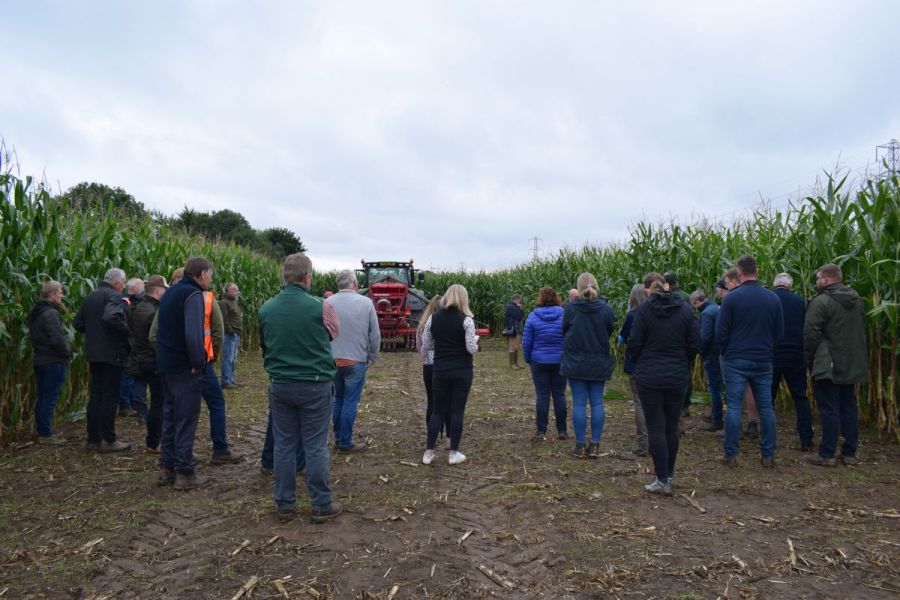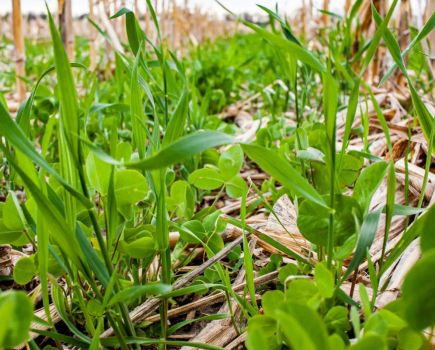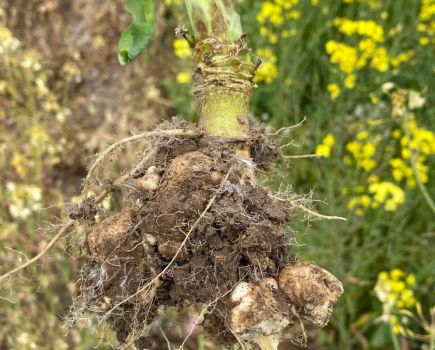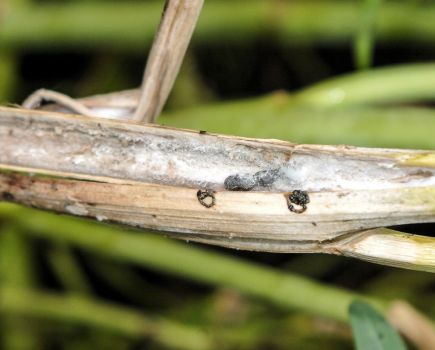Can maize shrug off its reputation of being a much-scrutinised crop that damages the environment and poses a flooding risk? CPM joined growers at Severn Trent’s Stoke Bardolph AD site to learn how to maximise yields in a sustainable way.
“We should defend this great crop which has much to offer.”
By Janine Adamson
Whether it’s for grain, forage or biogas, maize has faced much scrutiny over the years. In fact, around 10 years ago it caught the attention of environmental campaigner George Monbiot, who at the time proclaimed: “Maize farming could scarcely be better designed to cause soil erosion, compaction and run-off, which threaten the fertility of the land, the health of our freshwater ecosystems and the homes at risk from flooding.”
But times have undoubtedly moved on – net zero, sustainable agriculture and regenerative farming are words which frequent not only the media but on-farm conversations too. It’s widely accepted that the industry has a valuable role to play in ecosystem preservation, and as a result, various funding pots are available which reward growers for making appropriate actions.
Yet where does maize stand in all of this? Is it really the Lord Voldemort of a cropping rotation? According to John Morgan of the Maize Growers Association (MGA), the crop is more of a Hagrid – rather misunderstood, and yes, large and hairy too.
“This is a call to arms – we should defend this great crop which has much to offer,” he says, with a slightly indignant tone. And given he was speaking at a specialist event for maize growers who supply Severn Trent Green Power (food waste recycling and green waste composting network), it could be said he was preaching to the converted.
However, when presented with the evidence, does he have a point? For a start, maize is a C4 crop meaning it’s particularly efficient at converting sunlight to biomass through photosynthesis. For comparison, other C4 crops include sugarcane and sorghum.
It’s also relatively low-cost from an input perspective – fungicide requirements are minimal and it has the potential to scavenge for nutrients meaning less reliance on bagged fertiliser. Finally, it’s a preferred feedstock, whether that’s for cattle or anaerobic digestion (AD).
To make the most of these positive attributes, the challenges of the past have to be overcome whether that’s related to water quality or soil degradation, says John, and that a long-term problem is nitrate leaching.
“In the past, thanks to readily-available slurries and muck, too much nitrogen has been applied to maize compared with its actual requirements. This leached nitrogen can end up in aquifers and being pumped up through bore holes. Nitrate leaching is a big problem but it also poses an opportunity if we can solve it,” he says.
Then there’s soil compaction, which John believes centres around later harvesting dates. “Soils are dry in August due to minimal rainfall but this is often followed by a wet autumn. Soil strength quickly disintegrates in this type of scenario meaning travel should be discouraged to avoid compaction.
“Ideally, it’s best to aim to harvest maize in September when soils are drier, so it’s about finding ways to enable an earlier harvest date,” he explains.
According to John, this starts by asking whether the field is suitable to grow maize in the first place and conducting a simple risk assessment is the easiest way to find out. “The MGA has a tool which produces a score that translates to a guide on variety choice. The lower the score, the more suitable the field is for maize. On the contrary, if it exceeds the guidance, the crop shouldn’t be grown.
“We’ve conducted trials which also show that the sooner maize is in the ground, the sooner it can be harvested. Drilling should be targeted for April assuming the seedbed is good.”
John played down concerns that early drilled maize could be hit by frost, explaining the crop’s vulnerable growing point is ‘safe’ because it remains underground until around 5-leaf stage. However, drilling conditions play an important role in facilitating an earlier planting date – adequate soil moisture is a fundamental factor and soil temperature should be 8-10oC for 4-5 consecutive days.
“It’s all about seedbed quality – maize likes a fine tilth that isn’t over-cultivated. Soil testing is essential too and something to become accustomed to, even if you’ve not done much of in the past,” stresses John.
Recent years have seen undersowing maize become increasingly popular, which John says can help to address various challenges associated with growing the crop. For one, the enhanced root mass improves soil structure which makes for easier travel at harvest.
The technique also reduces both soil erosion and nutrient leaching (for the latter, research shows between 18-58%) while building soil fertility and organic matter. And done correctly, John says there’s no yield penalty for the maize crop.
“When undersowing with grass, you shouldn’t plant the two crops at the same time because maize doesn’t like competition during early establishment. Equally, timing is key to avoid damaging the maize.
“In low grassweed pressure scenarios, choose slower growing species such as fescues and plant when the maize is at 4-5 leaf stage. If weed pressure is high, drill when the maize is at 7-8 leaf stage using a faster growing species,” explains John. “Alternatives to grass for undersowing continue to be trialled and offer opportunities for those not keen on having grass in the fields.”
Stressing the importance of reducing nutrient leaching through such tactics, farmers at the event learned it costs Severn Trent around £20M to install nitrate removal facilities, which then cost £250,000 to operate each year.
In addition, a water treatment works spends around £150/ml of water to remove pesticides via the Granular Activated Carbon (GAC) method, which is commonly used to remove chemical contaminants. According to the company, some pesticide actives are harder to remove than others such as metaldehyde. However, nitrate leaching is high risk and remains a key focus for Severn Trent.
To encourage best practice, the Severn Trent Environmental Protection Scheme (STEPS) was devised to offer farmers in the catchment region financial and technical support to invest in solutions to help tackle diffuse water pollution, and protect and maintain biodiversity and the natural environment.
One STEPS funding option is for cover crops (STEPS008) which includes the option to claim for undersowing maize (tall fescue and/or perennial ryegrass) – £136/ha/yr for groundwater catchments and £60/ha/yr for surface catchments.
For cover crops planted following maize, the crop must remain in place until at least 15 January, after which it can be destroyed by chemical or mechanical means, or by grazing.
As for maize specifically, Severn Trent has been investigating how best to grow the crop for more than 10 years. Back in 2010, the company commissioned its energy crop AD plant at Stoke Bardolph in Nottingham.
The site, which generates 5.6MW of energy, was established to help power the nearby sewage treatment works using crops grown on adjacent farmland such as maize.
According to Severn Trent’s farms manager John Jackson, crop nutrition can be carefully balanced through a variety of means. “We only use diammonium phosphate (DAP) if it’s truly required because most phosphate comes from the application of organic manures, the crop rarely wants more.”
He says he’s found that most maize requires around 200kgN/ha whereas digestate provides a source of both potash and sulphur. However, overwintering a cover crop before planting maize pays dividends. “The cover crop delivers the nutrients that maize requires at the right time in the crop’s lifecycle due to the break-down period in the soil. From our experience, radish helps especially because it scavenges for nitrogen while breaking up any compaction.”
John Jackson also stresses the importance of minimising crop competition during early establishment. “The first six weeks are critical in terms of avoiding weed competition, you have to hit them early. We tend to use a pre-emergence spray of pendimethalin, to ensure maize can get up and away.”
When it comes to harvesting energy crops, it’s all about achieving the most DM/ha, which John Jackson says can still be achieved through a lower seed rate. “Because of lodging risk, we reduced our seed rate from 110,000 seeds/ha to 85,000 seeds/ha. It actually allows more sunlight into the crop to achieve earlier maturity. You want around 32-34% DM for the best gas yield,” he concludes.
Energy for Anglesey
Ensuring enough feedstock is grown to fuel an anaerobic digester and livestock in North Wales, and doing so in a mindful way, is the challenge both farmers and agronomists have, says Merfyn Parry.
Merfyn has been providing agronomic advice across the region, including Anglesey, for more than 40 years. His priority is helping mixed farmers to balance growing feed crops for livestock, and energy crops such as maize, hybrid rye and spring barley.
Whereas some may turn to undersowing maize after drilling to improve its sustainability credentials, Merfyn works with the management team on a large Anglesey estate to diversify the cropping rotation and avoid a maize-monoculture.
“Fields are never empty over the winter. Instead, once the maize comes off at the end of September, digestate is applied and hybrid rye is sown min-till to grow an energy crop for the digester which is harvested the following June.
“The ground is then lightly cultivated and sown into ryegrass (Italian or westerwold) for a crop of silage in August before being grazed by lambs over winter. This is followed by spring barley – some of which goes to the digester and the rest for whole crop silage for local dairy farmers, usually harvested in mid-July.”
Merfyn says it’s then ryegrass before finally going back into maize. “The majority of crops harvested for the digester are taken in between 30-34% dry matter (DM). The idea is to continually rotate the maize around the arable area to avoid a monoculture,” he explains.
Before this rotation was introduced, ground could be left bare following maize whereas stubble turnips followed spring barley or potatoes. But after the stubble turnips were grazed, there was a risk the land would be left bare again, which neither Merfyn or the estate supported.
With an AD plant commissioned on Anglesey he says it created an opportunity for a new partnership – the estate would grow the energy crops and the plant’s digestate would be applied to the land in return.
“Not only does it look better from a visual perspective, but it makes sense agronomically. The soil structure of the field has improved significantly and both weed and disease pressure are reduced because of the wider rotation.”
According to Merfyn, the requirements of an AD plant and a cow are rather similar. He says they both require starch and energy, not just green leaves, which means maize and hybrid rye have to deliver on quality.
As a result, Field Options (part of the ProCam group), is running maize trials on Anglesey to understand which varieties deliver the greatest DM yields within the island’s unique microclimate. He explains it’s important that varieties have a high score against eye spot and fusarium to maximise yields on the West Welsh coast which can be exposed to high winds.
“A lot of maize is grown in North Wales with average fresh yields between 44-51t/ha (14.5-17t/DM). Compare that with Anglesey, where you’re looking at 37-49t/ha (12-16t/DM) depending on the season,” concludes Merfyn.
This article was taken from the latest issue of CPM. Read the article in full here.
For more articles like this, subscribe here.
Sign up for Crop Production Magazine’s FREE e-newsletter here.




